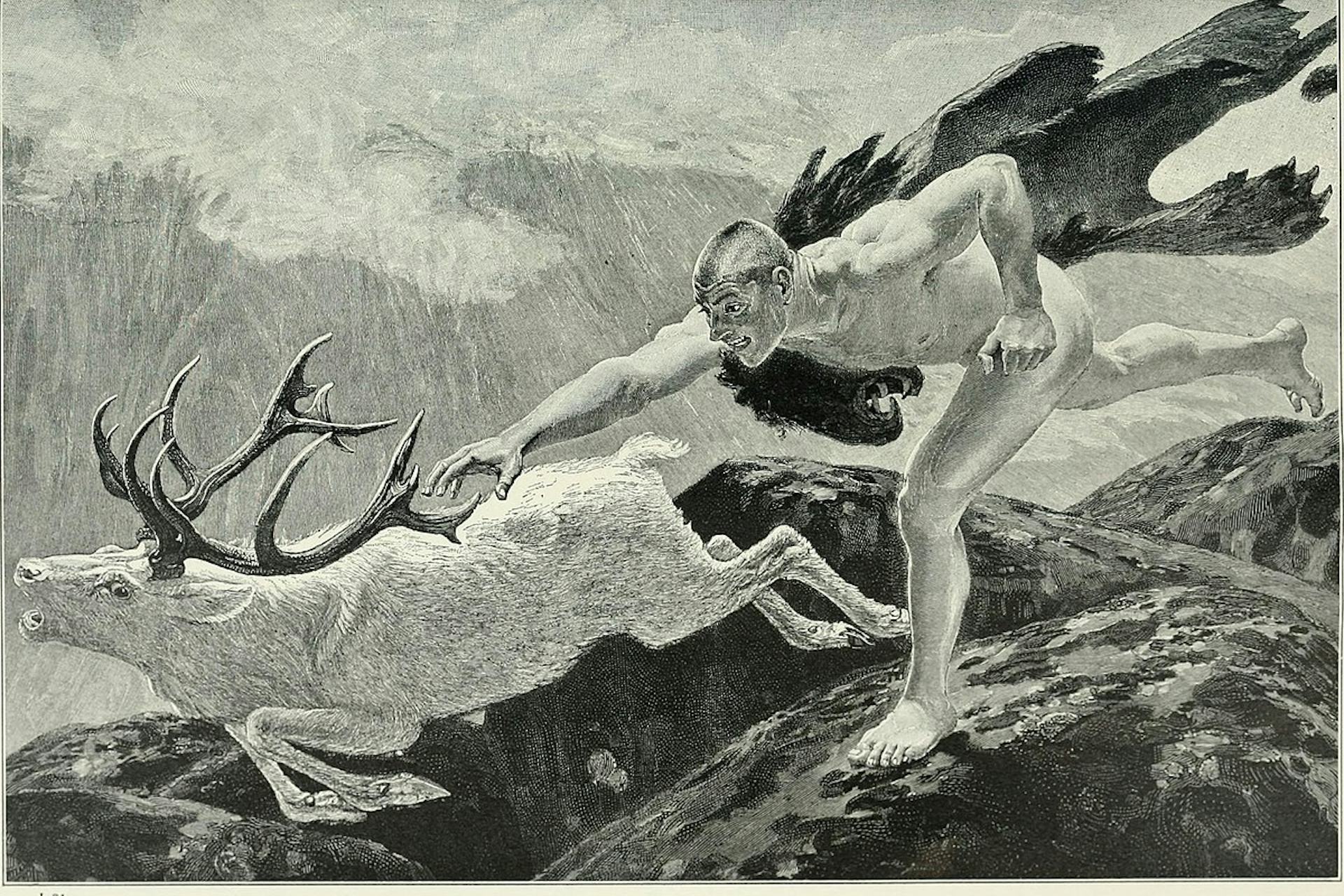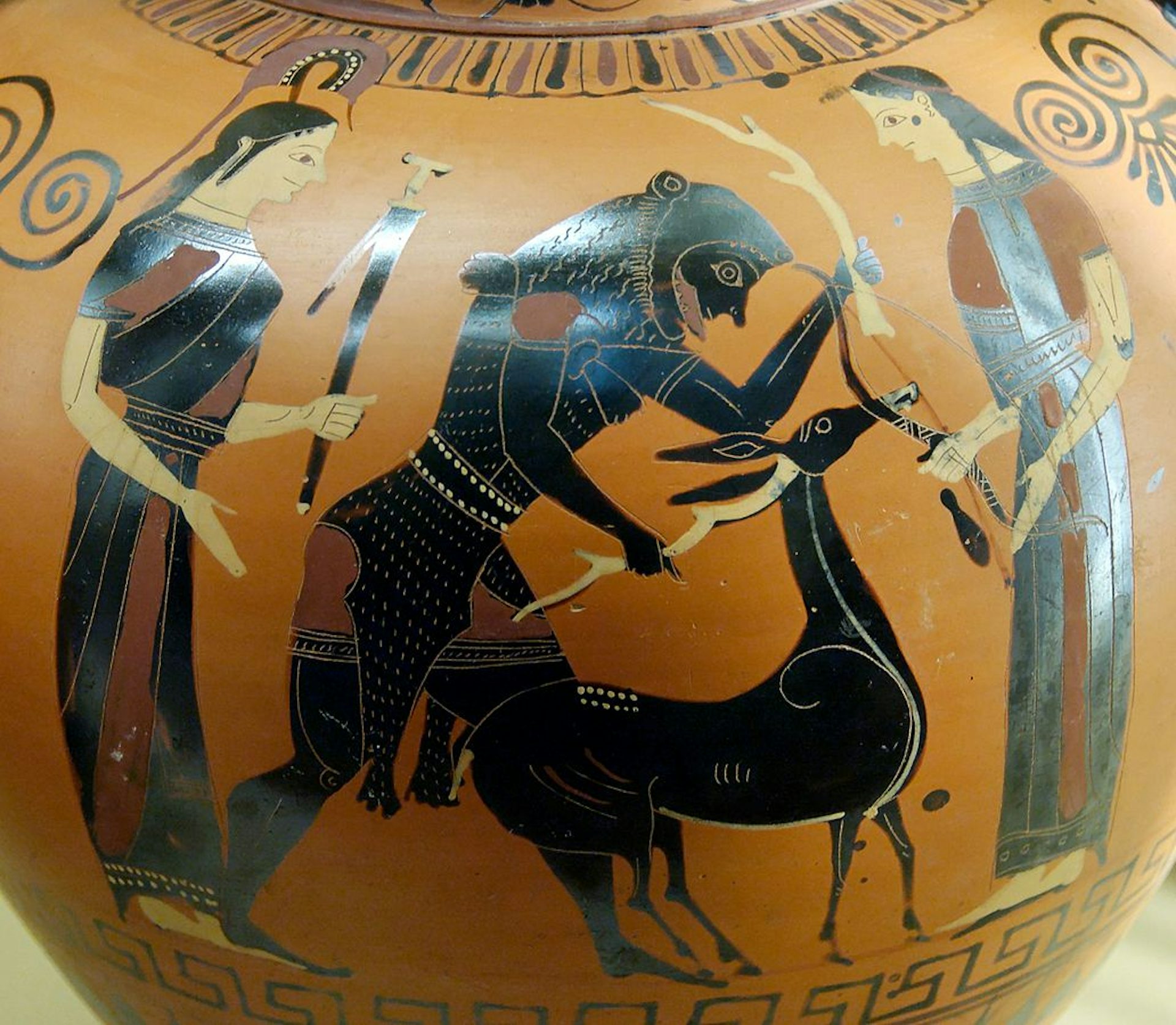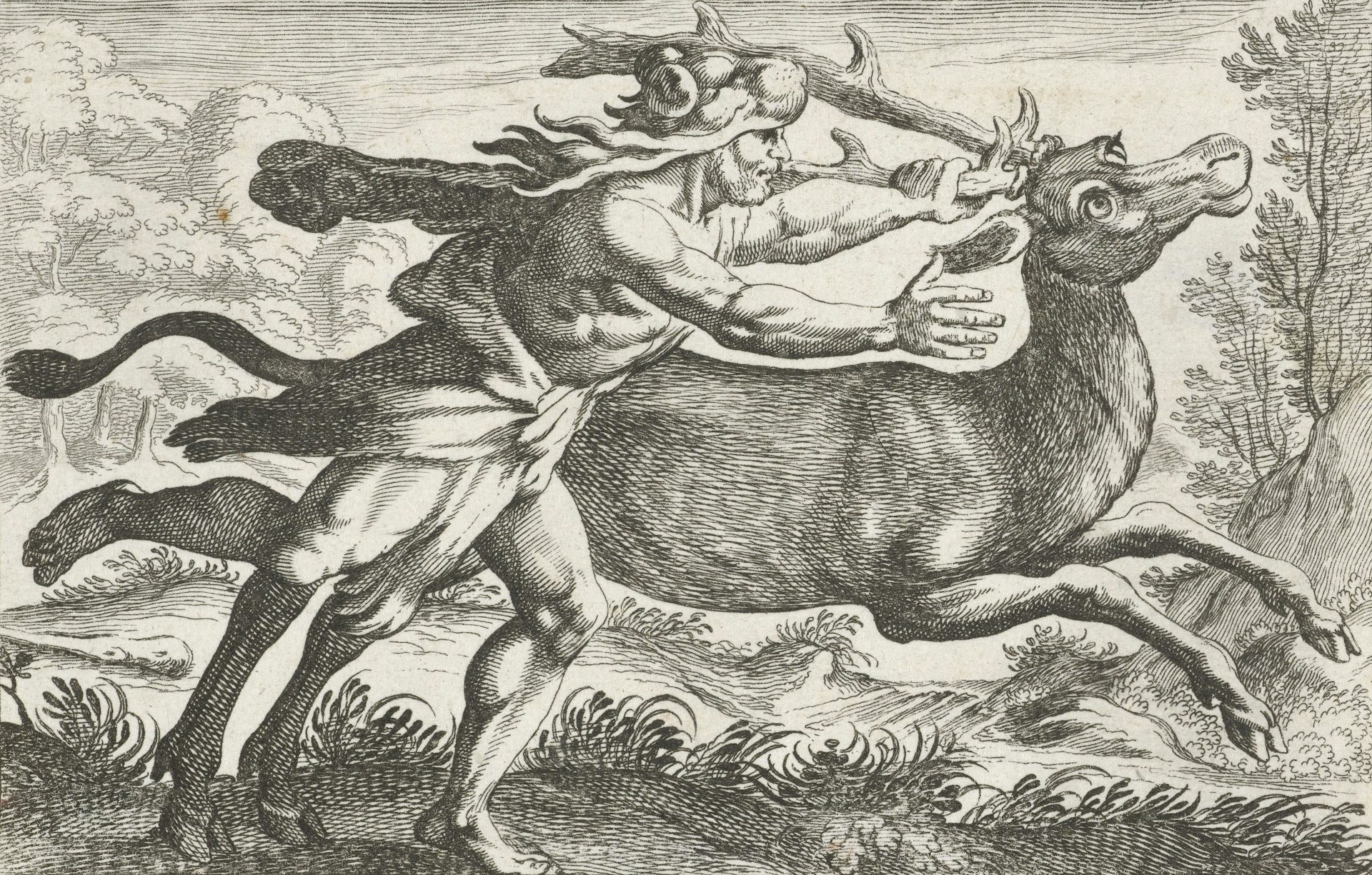Ceryneian Hind

Illustration of Heracles chasing the Ceryneian Hind. Edward Silvester Ellis and Charles F. Horne, The Story of the Greatest Nations (New York: Niglutsch, 1913)
University of California LibrariesPublic DomainOverview
The Ceryneian Hind was a remarkable female deer; ancient sources described it as incredibly large and fast and endowed with golden antlers. It was sacred to Artemis, the Olympian goddess of the wild, and lived near the town of Ceryneia in Achaea.
The great hero Heracles was sent to capture the Ceryneian Hind for the third of his Twelve Labors. According to most accounts, Heracles knew that the hind was sacred to Artemis and therefore made sure to take it alive. But there was at least one version of the myth in which he slew the creature.
Etymology
The Ceryneian Hind (Greek Κερυνῖτις ἔλαφος, translit. Kerynȋtis élaphos) was named after either the town of Ceryneia in Achaea or the Cerynites River.[1]
Pronunciation
English
Greek
Ceryneian Hind Κερυνῖτις ἔλαφος (translit. Kerynȋtis élaphos) Phonetic
IPA
[ser-IN-ee-uhn hahynd] /sər ˈɪn i ən haɪnd/
Alternate Names
Sources in the English-speaking world sometimes refer to the Ceryneian Hind by other names, including the “Hind of Ceryneia,” “the Cerynitian Hind,” “the Ceryneian Deer,” or “the Golden Hind.”
In the ancient world, alternate names for the Ceryneian Hind were a bit more varied. A number of sources knew the creature as “the Golden-Horned Hind” (Greek χρυσόκερως ἔλαφος, translit. chrysókerōs élaphos).[2] Other alternate names included “the Parrhasian Hind”[3] and “the Creature of Maenalus.”[4]
Attributes
Locale
The Ceryneian Hind, as its name suggests, was tied to Ceryneia, a town in the region of Achaea in the northern Peloponnese. It is reasonable to assume that the hind lived near Ceryneia or the Cerynites River, which flowed by the town.
Some sources, however, gave the Ceryneian Hind other haunts. According to Pindar, Heracles sought the hind further north, in “the land of the Danube” and “beyond the cold blasts of Boreas”[5]—that is, in the mythical land of the Hyperboreans.
According to Apollodorus, on the other hand, Heracles did not have to go as far, finding the hind at Oenoe in the Argolid (not far from his own ancestral cities of Tiryns and Mycenae) and pursuing it through Arcadia.[6] The Ceryneian Hind was thus sometimes associated with the region of Arcadia, which bordered Achaea.
Finally, according to Callimachus, the original home of the Ceryneian Hind was Mount Parrhasia in Arcadia, from which Artemis chased it to the mountains of Ceryneia.[7]
The Ceryneian Hind was also associated with other parts of Achaea and Arcadia, including Mount Maenalus (see above).
Appearance and Abilities
The Ceryneian Hind was a female deer with several notable characteristics. For one, its size was remarkable; according to Callimachus, the Ceryneian Hind came from a herd of deer who were all “larger than bulls.”[8] It was also famously fast.[9] Perhaps most distinctively, it had horns or antlers (a feature usually associated with male rather than female deer) that were made of gold.[10]
Various accounts added that the Ceryneian Hind had a dappled hide,[11] brazen hoofs,[12] or even breathed fire.[13] A few sources claimed that the Ceryneian Hind was violent and that it “preyed upon the country-folk.”[14]
Iconography
Depictions of Heracles’ struggle with the Ceryneian Hind can be found in ancient sculpture, vase paintings, and mosaics. The creature was often represented trying to escape from Heracles as the hero held it by its antlers. In some images, the hind is being carried by Heracles back to Eurystheus, while in others Apollo or Artemis try to take the sacred creature back.[15]

Attic black-figure neck amphora showing Heracles wrestling the Ceryneian Hind as Artemis (right) and Athena (left) look on (ca. 540–530 BCE). Found in Vulci. British Museum, London.
jastrowPublic DomainMythology
Origins
The origins of the Ceryneian Hind are obscure. Its parents are not named anywhere (for all we know, they might have simply been ordinary deer). Most sources agree that the Ceryneian Hind was sacred to the goddess Artemis, and some add that it was the nymph Taygete who originally dedicated the hind to her (she may have been the one who gilded its horns).[16]
In one story, recounted by Callimachus, the Ceryneian Hind at first belonged to a herd of five enormous horned deer who lived on Mount Parrhasia in Arcadia. These magnificent creatures caught the eye of Artemis, who captured four of them and harnessed them to her chariot. But one got away and came to Ceryneia, where Hera kept it as a future challenge for her mortal nemesis Heracles.[17]

The Diana of Versailles, also known as Artemis with a Hind. Roman copy from the first or second century CE, based on a Greek original. Keroen van Luin.
FlickrCC BY 2.0Heracles’ Third (or Fourth) Labor
Heracles was sent to catch the Ceryneian Hind as one of his Twelve Labors. Hera, who hated the hero because he was the bastard son of her husband Zeus, forced Heracles to complete these grueling tasks for his cousin Eurystheus, the king of Mycenae. Capturing the Ceryneian Hind was either the third or fourth labor (at least in the canonical literary sources).[18]
In most accounts, Heracles knew that the Ceryneian Hind was sacred to Artemis and did not wish to anger the goddess by killing or wounding the creature. He therefore spent a long time chasing the hind—as long as a whole year, according to some sources.

Hercules catching the hind of Cerynea by Simon Frisius, after Antonio Tempesta (ca. 1610–64).
RijksmuseumPublic DomainThough Heracles finally managed to capture the Ceryneian Hind alive, there are different accounts of how he accomplished this. In one, the hind arrived at Mount Artemisius in Arcadia, where it tried to cross the Ladon River. But just as it was about to cross, Heracles shot its legs with one of his arrows.[19]
In other versions of the myth, Heracles caught the Ceryneian Hind by trapping it in a net, sneaking up on it while it was sleeping, running it down, or wrestling and overpowering it.[20]
Finally, there was another version of the myth that made the Ceryneian Hind a pest who ravaged fields and killed farmers and herdsmen. In this version, Heracles wrestled the hind and—according to at least one author—ultimately killed it.[21]

Hercules Wrestling the Golden Hind by Adolf Schmidt (19th century). Neues Museum, Berlin, Germany.
ONARCC BY-SA 3.0The Wrath of Artemis
According to Apollodorus, Artemis and Apollo stopped Heracles as he was carrying the Ceryneian Hind back to Eurystheus. The situation nearly turned violent, with Artemis wishing to punish Heracles for threatening her sacred pet and Apollo eager to support his twin sister. But Heracles was able to explain the situation: it was Eurystheus who had forced him to capture the Ceryneian Hind. In the end, Apollo and Artemis allowed the hero to go on his way. [22]
This myth is also found in some ancient Greek vase paintings, some of which show Heracles, Apollo, and Artemis wrestling for the hind in a sort of tug-of-war.[23]

Attic black-figure amphora showing Heracles and Apollo wrestling for the Ceryneian Hind as Athena (right) and Artemis (left) stand by (ca. 530–520 BCE). Louvre Museum, Paris, France.
JastrowPublic DomainInterpreting the Ceryneian Hind
Scholars have long puzzled over the Ceryneian Hind’s antlers. After all, antlers are a characteristic of male deer (“stags”), not female deer (“hinds”)—a fact that was already well-known to the ancient Greeks.
Some have therefore interpreted the Ceryneian Hind as a reindeer, since female reindeer do have antlers. This might explain why some sources, such as Pindar, located the Ceryneian Hind in the far north (that is, closer to the reindeer’s natural habitat).[24]
Others, however, have suggested that the Ceryneian Hind’s antlers were actually a feature of an aetiological myth—that is, a myth that explains why the world is the way it is. In this case, the hind, which may have lost one or more of its antlers in its battle with Heracles (as shown in some artistic representations of the labor), would serve to illustrate why female deer do not have antlers.
Still other scholars have speculated that the original storyteller may have simply made a mistake, or that the Ceryneian Hind’s zoologically improbable antlers were simply meant to add to the creature’s “mystique.”[25]
Pop Culture
The Ceryneian Hind has appeared in several pop culture adaptations of the Heracles myth. As is often the case, these modern representations tend to depart from the ancient mythological sources. In the 1990s TV series Hercules: The Legendary Journeys, for example, the Ceryneian Hind—called the “Golden Hind”—is portrayed as a half-woman, half-deer creature with golden hooves and horns (somewhat resembling a Centaur).